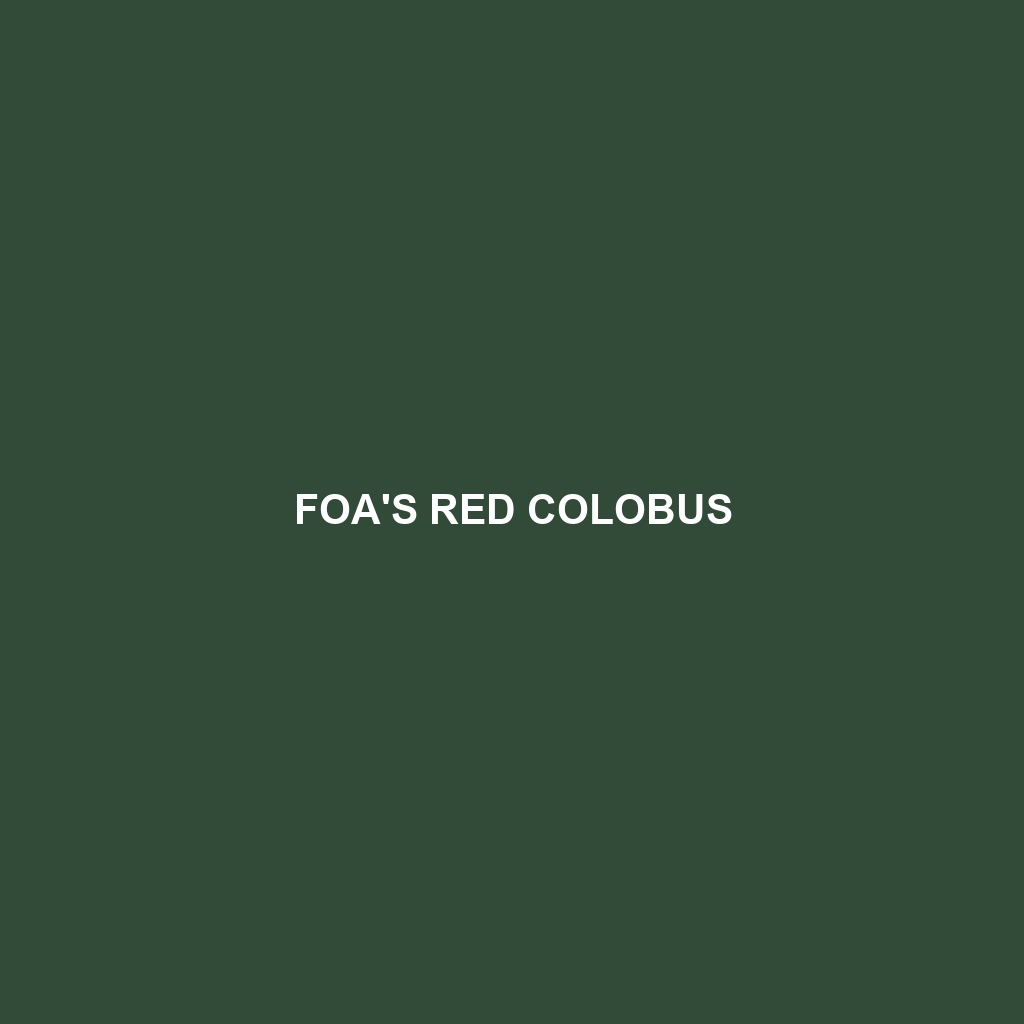Foa’s Red Colobus
Foa’s Red Colobus (Piliocolobus foai) is a striking and elusive primate species that inhabits the lush forested regions of Central Africa. Known for their vibrant reddish-brown fur and unique social structure, these monkeys play a critical role in their ecosystem. Unfortunately, they are facing significant threats due to habitat loss and hunting, making them a priority for conservation efforts.
Physical Characteristics:
Size: Foa’s Red Colobus are medium-sized monkeys, with adults typically weighing between 5 to 10 kilograms (11 to 22 pounds) and having a body length (excluding the tail) of about 45 to 70 centimeters (17.7 to 27.6 inches). Their tails can be quite long, often reaching up to 80 centimeters (31.5 inches).
Coloration: Their fur is predominantly reddish-brown, which gives them their name. The coloration can vary slightly among individuals, with some having more pronounced red hues, while others may exhibit darker, almost black tones on their limbs and face.
Special Features: One of their most distinguishing features is their elongated fingers and toes, which are adapted for an arboreal lifestyle. Unlike many other primates, they lack thumbs, an adaptation that helps them navigate through the dense forest canopy with ease. Their facial features include a dark, almost black face with a pronounced brow ridge, giving them a distinctive, expressive look.
Behaviors:
Social Interactions: Foa’s Red Colobus are highly social animals that live in large, mixed-gender groups ranging from 20 to over 100 individuals. They exhibit complex social structures and are known for their vocal communication, which includes a variety of calls to coordinate group movements, signal alarm, and maintain social bonds.
Feeding Habits: These primates are primarily folivorous, feeding mostly on leaves, but they also consume fruits, seeds, and flowers. Their specialized digestive system allows them to process a high-fiber diet, which is supplemented by symbiotic bacteria in their stomachs.
Ecological Roles: As folivores, Foa’s Red Colobus play a crucial role in their ecosystem by aiding in seed dispersal and maintaining the health of the forest canopy. Their feeding habits help regulate plant growth and contribute to the biodiversity of their habitat.
Habitat:
Geographic Range: Foa’s Red Colobus are primarily found in the central African regions, including parts of the Democratic Republic of Congo, Uganda, and Rwanda.
Preferred Environment: They thrive in primary and secondary tropical rainforests, often preferring areas with a dense canopy that offers abundant food sources and protection from predators. These monkeys are almost entirely arboreal, rarely descending to the ground.
Adaptations:
Arboreal Lifestyle: Their long limbs, prehensile tails, and lack of thumbs are adaptations that facilitate efficient movement through the trees. These features allow them to leap between branches and navigate the forest canopy with agility.
Digestive System: Foa’s Red Colobus have a specialized, multi-chambered stomach that houses bacteria to ferment and break down tough plant material, allowing them to extract maximum nutrients from their folivorous diet.
Conservation Status:
Threats: The primary threats to Foa’s Red Colobus include habitat destruction due to logging, agriculture, and human settlement, as well as hunting for bushmeat. These pressures have led to significant population declines in many areas.
Conservation Efforts: Efforts to protect Foa’s Red Colobus include habitat preservation, anti-poaching initiatives, and fostering community-based conservation programs. Protected areas and national parks play a crucial role in safeguarding their remaining populations.
Fun Facts:
1. Vocal Communication: Foa’s Red Colobus are known for their complex vocalizations. They can produce a wide range of sounds, including grunts, purrs, and screams, which they use to communicate with each other and to warn of approaching predators.
2. Thumb-less: Unlike many primates, Foa’s Red Colobus lack thumbs. This unique adaptation is believed to aid their movement through the forest canopy.
3. Symbiotic Relationships: Their digestive system relies on a symbiotic relationship with bacteria that help break down cellulose in their leafy diet, enabling them to thrive on a diet that many other animals cannot.
By understanding and appreciating the unique attributes of Foa’s Red Colobus, we can better appreciate the importance of conserving these magnificent primates and their forest habitats.
